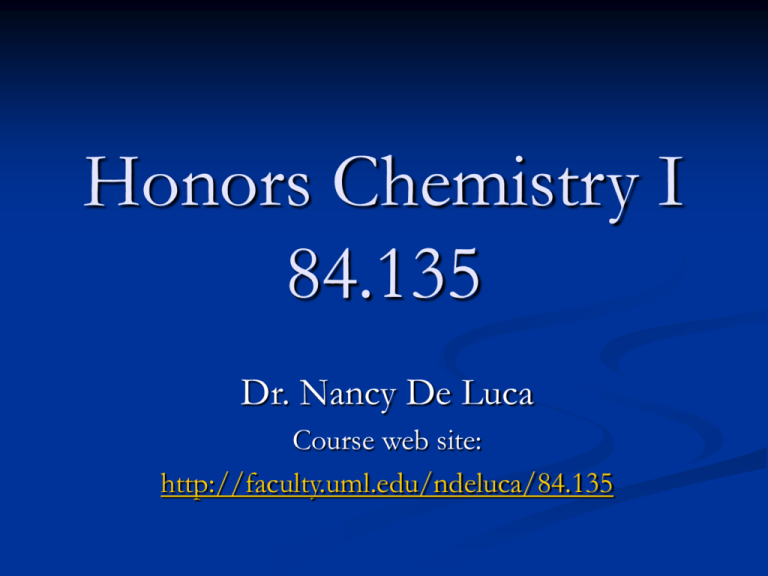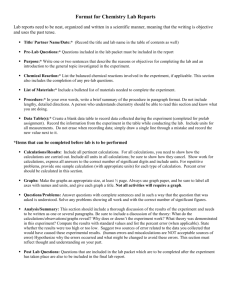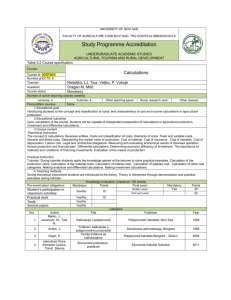Significant Figures
advertisement

Honors Chemistry I 84.135 Dr. Nancy De Luca Course web site: http://faculty.uml.edu/ndeluca/84.135 Text Information If you choose to purchase CONNECTPLUS for $115, and later regret not having a print book, you can purchase a loose leaf edition of the text for $80 from within your ConnectPlus home screen. Connect/Learnsmart You can access your homework assignments and also review specific areas of study on line. The link is: http://connect.customer.mheducation.com/stu dent-start/ You get 14 days of courtesy access before you must purchase access to the system. Chapter 1 Review Topics The following topics should be fairly familiar to you, and will not be covered in detail. Chapter 1: Classification of Matter Physical and Chemical Changes & Properties Units of Measurement Chapter 1 Review Topics You can review your knowledge of these topics using LearnSmart Prep™ which can be found on the online homework system. Matter Matter is anything that has mass and occupies space. It includes everything around us, including the air that we breath, our skin and bones, and the earth underneath us. Properties of Matter Matter can be described by its physical or chemical properties. Physical properties are a description of the substance, and include mass, color, physical state (solid, liquid or gas) at a specific temperature, density, melting or boiling point, odor, solubility, etc. Properties of Matter During a physical change, the chemical identity of the substance or substances does not change. Examples of physical changes include evaporation, filtration, and changes of state. Physical Changes When water boils, its chemical composition remains the same. The molecules are now farther apart. Physical Change The dissolving of sugar in water is a physical change. The chemical identity of the water and the sugar remain unchanged. Filtration During filtration, liquids are separated from solids by physical means. The liquid and solid maintain their chemical identity. Distillation During distillation, liquids may be separated from other liquids, or from solids. The chemical identity of each component remains unchanged. Properties of Matter Chemical properties are descriptions of how a substance reacts chemically. Examples include the rusting of iron in the presence of air and water, the souring of milk, or the burning of paper to form carbon dioxide and water vapor. Chemical Changes As iron rusts, the iron atoms combine with oxygen in the air to form a new substance, rust, or iron (III) oxide. Chemical Changes During a chemical change, atoms rearrange the way they are attached to each other, forming new substances with properties that are often quite different from the starting materials. Intensive & Extensive Properties Intensive properties do not depend on the amount or quantity of matter. Melting point, chemical formula and color are intensive properties. Extensive properties depend upon the quantity of matter or sample size. Examples include length, mass and volume. Measurement - Units Common English-Metric Conversion Factors 2.54 cm = 1 inch 1 lb = 453.6 g 1 qt = 943 mL Measurements Prefixes Commonly used in Chemistry: prefix name symbol value exponential notation kilo centi milli micro nano pico k 1,000 c 1/100 or .01 m 1/1,000 or .001 µ .000001 n p 103 10-2 10-3 10-6 10-9 10-12 Measurement - Temperature In the chemistry lab, temperature is measured in degrees Celsius or Centigrade. The temperature in Kelvins is found by adding 273.15 The Fahrenheit scale has 180 oF/100 oC. This is reason for the 5/9 or 9/5 in the conversion formulas. Significant Figures When writing a number, the certainty with which the number is known should be reflected in the way it is written. Digits which are the result of measurement or are known with a degree of certainty are called significant digits or significant figures. Significant Figures The goal of paying attention to significant figures is to make sure that every number accurately reflects the degree of certainty or precision to which it is known. Likewise, when calculations are performed, the final result should reflect the same degree of certainty as the least certain quantity in the calculation. Significant Figures If someone says “There are roughly a hundred students enrolled in the freshman chemistry course,” the enrollment should be written as 100 or 1 x 102. Either notation indicates that the number is approximate, with only one significant figure. Significant Figures If the enrollment is exactly one hundred students, the number should be written with a decimal point, as 100. , or 1.00 x 102. Note that in either form, the number has three significant figures. Significant Figures The rules for counting significant figures: 1. Any non-zero integer is a significant figure. Significant Figures 2. Zeros may be significant, depending upon where they appear in a number. a) Leading zeros (one that precede any nonzero digits) are not significant. For example, in 0.02080, the first two zeros are not significant. They only serve to place the decimal point. Significant Figures – Zeros (cont’d) b) Zeros between non-zero integers are always significant. In the number 0.02080, the zero between the 2 and the 8 is a significant digit. c) Zeros at the right end of a number are significant only if the number contains a decimal point. In the number 0.02080, the last zero is the result of a measurement, and is significant. Significant Figures Thus, the number 0.02080 has four significant figures. If written in scientific notation, all significant digits must appear. So 0.02080 becomes 2.080 x 10-2. Significant Figures 3. Exact numbers have an unlimited number of significant figures. Examples are 100cm = 1m, the “2” in the formula 2πr, or the number of atoms of a given element in the formula of a compound, such as the “2” in H2O. Using an exact number in a calculation will not limit the number of significant figures in the final result. Significant Figures - Calculations When calculations are performed, the final result should reflect the same degree of certainty as the least certain quantity in the calculation. That is, the least certain quantity will influence the degree of certainty in the final result of the calculation. Significant Figures - Calculations There are two sets of rules when performing calculations. One for addition and subtraction, and the other for multiplication and division. For Multiplication and Division: The result of the calculation should have the same number of significant figures as the least precise measurement used in the calculation. Significant Figures - Calculations Multiplication & Division: Example: Determine the density of an object with a volume of 5.70 cm3 and a mass of 8.9076 grams. Significant Figures - Calculations Multiplication & Division: Example: Determine the density of an object with a volume of 5.70 cm3 and a mass of 8.9076 grams. δ = mass/volume = 8.9076 g/5.70 cm3 δ = 1.5627368 = 1.56 g/cm3 Significant Figures - Calculations Addition and Subtraction: The result has the same number of places after the decimal as the least precise measurement in the calculation. For example, calculate the sum of: 10.011g + 5.30g + 9.7093g = 25.0203 = 25.02g Significant Figures - Measurement All measurements involve some degree of uncertainty. When reading a mass from a digital analytical balance, the last digit (usually one-ten thousandth of a gram) is understood to be uncertain. When using other devices in the laboratory, such as a ruler, graduated cylinder, buret, etc., you should estimate one place beyond the smallest divisions on the device. Significant Figures - Measurements The volume should be estimated to the nearest hundredth of a milliliter, since the buret is marked in tenths of a milliliter. The correct reading is 20.15 (or 20.14 or 20.16) mL. It is understood that the last number is uncertain. Significant Figures - Measurements The value of 20.15 mL indicates a volume in between 20.1 mL and 20.2 mL. If the liquid level were resting right on one of the divisions, the reading should reflect this by ending in a zero. Conversion of Units Many chemical calculations involve the conversion of units. An example is calculating how many grams of a product can be obtained from a given mass of a reactant. The calculation involves going from mass of reactant to moles of reactant to moles of product to grams of product. You should write in your units for all calculations, and make sure they cancel properly. Metric Conversion Factors These conversion factors are useful and worth learning. 1 inch = 2.54 cm 1 lb = 454.6 g 1 L = 1.0567 qt Problem The density of mercury is 13.6 g/mL. What is the weight, in lbs, of a quart of mercury? Accuracy & Precision Most experiments are performed several times to help ensure that the results are meaningful. A single experiment might provide an erroneous result if there is an equipment failure or if a sample is contaminated. By performing several trials, the results may be more reliable. Accuracy & Precision If the experimental values are close to the actual value (if it is known), the data is said to be accurate. If the experimental values are all very similar and reproducible, the data is said to be precise. The goal in making scientific measurements is to that the data be both accurate and precise. Accuracy & Precision Data can be precise, but inaccurate. If a faulty piece of equipment or a contaminated sample is used for all trials, the data may be in agreement (precise), but inaccurate. Such an error is called a systematic error. If the scientist has good technique, the results will be similar, but too high or too low due to the systematic error. Random Error In many experiments, data varies a bit with each trial. The variation in the results is due to random error. Examples might be estimating the last digit for the volume in a buret. Random errors have an equal probability of being too high or too low. As a result, if enough trials are performed, the random error will average itself out.






